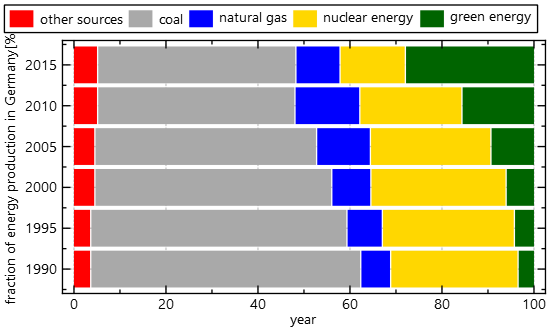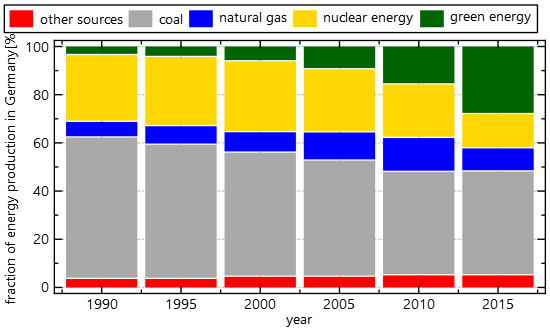mirror of
https://github.com/jkriege2/JKQtPlotter.git
synced 2025-01-26 15:39:09 +08:00
5.8 KiB
5.8 KiB
Example (JKQtPlotter): Simple stacked barchart
This project (see ./examples/simpletest_stackedbars/) simply creates a JKQtPlotter widget (as a new window) and adds several stacked barcharts.
The soruce code of the main application is (see jkqtplotter_simpletest_stackedbars.cpp:
#include <QApplication>
#include "jkqtplotter/jkqtplotter.h"
#include "jkqtplotter/jkqtpgraphsbarchart.h"
#define Ndata 5
int main(int argc, char* argv[])
{
QApplication app(argc, argv);
// 1. create a plotter window and get a pointer to the internal datastore (for convenience)
JKQtPlotter plot;
plot.get_plotter()->set_useAntiAliasingForGraphs(true); // nicer (but slower) plotting
plot.get_plotter()->set_useAntiAliasingForSystem(true); // nicer (but slower) plotting
plot.get_plotter()->set_useAntiAliasingForText(true); // nicer (but slower) text rendering
JKQTPdatastore* ds=plot.getDatastore();
// 2. now we create data for the charts (taken from https://commons.wikimedia.org/wiki/File:Energiemix_Deutschland.svg)
QVector<double> year, percentage_other, percentage_coaloil, percentage_gas, percentage_nuclear, percentage_green;
year << 1990 << 1995 << 2000 << 2005 << 2010 << 2015;
percentage_other << 3.5 << 3.5 << 4.4 << 4.4 << 5 << 5 ;
percentage_coaloil << 58.7 << 55.7 << 51.5 << 48.2 << 42.9 << 43.1;
percentage_gas << 6.5 << 7.7 << 8.5 << 11.7 << 14.1 << 9.6 ;
percentage_nuclear << 27.7 << 28.7 << 29.4 << 26.2 << 22.2 << 14.2;
percentage_green << 3.6 << 4.4 << 6.2 << 9.5 << 15.8 << 28.1;
// 3. make data available to JKQtPlotter by adding it to the internal datastore.
// Note: In this step the data is copied (of not specified otherwise)
// the variables cYear, cOther ... will contain the internal column ID of the
// newly created columns with names "year" and "other" ... and the (copied) data
size_t cYear=ds->addCopiedColumn(year, "year");
size_t cOther=ds->addCopiedColumn(percentage_other, "other");
size_t cCoalOil=ds->addCopiedColumn(percentage_coaloil, "coal & oil");
size_t cGas=ds->addCopiedColumn(percentage_gas, "natural gas");
size_t cNuclear=ds->addCopiedColumn(percentage_nuclear, "nuclear energy");
size_t cGreen=ds->addCopiedColumn(percentage_green, "green energy");
// 4. create graphs in the plot, which plots the dataset year/other, year/coal, ...
// The color of the graphs is set by calling set_fillColor_and_darkenedColor(), which sets the
// fillColor to the given color and makes the outline of the bars (i.e. their "color") a darker
// shade of the given color.
QVector<JKQTPbarVerticalStackableGraph*> graphs;
graphs.push_back(new JKQTPbarVerticalStackableGraph(&plot));
graphs.back()->set_xColumn(cYear);
graphs.back()->set_yColumn(cOther);
graphs.back()->set_title(QObject::tr("other sources"));
graphs.back()->set_fillColor_and_darkenedColor(QColor("red"));
graphs.push_back(new JKQTPbarVerticalStackableGraph(&plot));
graphs.back()->set_xColumn(cYear);
graphs.back()->set_yColumn(cCoalOil);
graphs.back()->set_title(QObject::tr("coal & oil"));
graphs.back()->set_fillColor_and_darkenedColor(QColor("darkgrey"));
graphs.back()->stackUpon(graphs[graphs.size()-2]);
graphs.push_back(new JKQTPbarVerticalStackableGraph(&plot));
graphs.back()->set_xColumn(cYear);
graphs.back()->set_yColumn(cGas);
graphs.back()->set_title(QObject::tr("natural gas"));
graphs.back()->set_fillColor_and_darkenedColor(QColor("blue"));
graphs.back()->stackUpon(graphs[graphs.size()-2]);
graphs.push_back(new JKQTPbarVerticalStackableGraph(&plot));
graphs.back()->set_xColumn(cYear);
graphs.back()->set_yColumn(cNuclear);
graphs.back()->set_title(QObject::tr("nuclear energy"));
graphs.back()->set_fillColor_and_darkenedColor(QColor("gold"));
graphs.back()->stackUpon(graphs[graphs.size()-2]);
graphs.push_back(new JKQTPbarVerticalStackableGraph(&plot));
graphs.back()->set_xColumn(cYear);
graphs.back()->set_yColumn(cGreen);
graphs.back()->set_title(QObject::tr("green energy"));
graphs.back()->set_fillColor_and_darkenedColor(QColor("darkgreen"));
graphs.back()->stackUpon(graphs[graphs.size()-2]);
// 5. add the graphs to the plot, so it is actually displayed
plot.addGraphs(graphs);
// 6. set axis labels
plot.get_xAxis()->set_axisLabel("year");
plot.get_yAxis()->set_axisLabel("fraction of energy production in Germany [%]");
// 7. finally we move the plot key/legend to the outside, top-right
// and lay it out as a single row
// NOTE: plot is a descendent of QWidget, which uses an internal object of
// type JKQTBasePlotter, which does the actual plotting.
// So many properties of the plot are only available in this internal
// object, which you can access by plot.get_plotter().
plot.get_plotter()->set_keyPosition(JKQTPkeyOutsideTopRight);
plot.get_plotter()->set_keyLayout(JKQTPkeyLayoutOneRow);
// 8 autoscale the plot so the graph is contained
plot.zoomToFit();
// show plotter and make it a decent size
plot.show();
plot.resize(600,400);
return app.exec();
}
The result looks like this:
If you use JKQTPbarHorizontalGraphStacked instead of JKQTPbarVerticalStackableGraph, you'll get a result like this:

